#king charles iii name history
Explore tagged Tumblr posts
Text
"Because Richard (III) usurped the throne, his retinue is inevitably seen as inimical to the crown and therefore in an important sense independent of royal authority. In the context of Edward IV's reign, in which the retinue was created, neither assumption is true. The development of the retinue would have been impossible without royal backing and reflected, rather than negated, the king's authority. Within the north itself, Gloucester's connection subsumed that of the crown. Elsewhere, in East Anglia and in Wales, that focus for royal servants was provided by others, but Gloucester was still part of that royal connection, not remote from it. In the rest of England, as constable and admiral, he had contributed to the enforcement of royal authority. When he seized power in 1483 he did not do it from outside the prevailing political structure but from its heart."
-Rosemary Horrox, "Richard III: A Study of Service"
#richard iii#english history#my post#Richard was certainly very powerful in the north but to claim that he 'practically ruled' or was king in all but name is very misleading#his power/success/popularity were not detached from Edward IV's rule but a fundamental part/reflection/extension of Edward IV's rule#even more so that anyone else because he was Edward's own brother#there's also the 1475 clause to consider: Richard & Anne would hold their titles jointly and in descent only as long as George Neville#also had heirs. Otherwise Richard's title would revert to life interest. His power was certainly exceptional but his position wasn't as#absolute or indefinite as is often assumed. It WAS fundamentally tied to his brother's favor just like everyone else#and Richard was evidently aware of that (you could even argue that his actions in 1483 reflected his insecurity in that regard)#once again: when discussing Edward IV's reign & Richard III's subsequent usurpation it's really important to not fall prey to hindsight#for example: A.J Pollard's assumption that Edward IV had no choice but to helplessly give into his overbearing brothers' demands#and had to use all his strength to make Richard to heed to his command which fell apart after he died and Richard was unleashed#(which subsequently forms the basis of Pollard's criticism of Edward IV's reign & character along with his misinterpretation of the actions#of Edward IV's council & its main players after his death who were nowhere near as divided or hostile as Pollard assumes)#is laughably inaccurate. Edward IV was certainly indulgent and was more passive/encouraging where Richard (solely Richard) was concerned#but he was by no means unaware or insert. His backing was necessary to build up Richard's power and he was clearly involved & invested#evidenced by how he systematically depowered George of Clarence (which Clarence explicitly recognized) and empowered Richard#and in any case: to use Richard as an example to generalize assumptions of the power other magnates held during Edward IV's reign#- and to judge Edward's reign with that specific assumption in mind - is extremely misleading and objectively inaccurate#Richard's power was singular and exceptional and undoubtedly tied to the fact that he was Edward's own brother. It wasn't commonplace.#as Horrox says: apart from Richard the power enjoyed by noble associates under Edward IV was fairly analogous to the power enjoyed by#noble associates under Henry VII. and absolutely nobody claims that HE over-powered or was ruled by his nobles or subjects#the idea that Richard's usurpation was 'inevitable' and the direct result of Edward empowering him is laughable#contemporaries unanimously expected Edward V's peaceful succession. Why on earth would anyone - least of all Edward -#expect Richard to usurp his own nephew in a way that went far beyond the political norms of the time?#that was the key reason why the usurpation was possible at all#as David Horspool says: RICHARD was the 'overriding factor' of his own usurpation There's no need to minimize or outright deny his agency#as Charles Ross evidently did
13 notes
·
View notes
Text
Gallery Collection 001

Published: 2-21-2024 | Updated: N/A SUMMARY This is the first in a series of upcoming investment objects for Sims 2 – things your sims can use to generate income over time. From 1975-2000, Anheuser-Busch, Inc. commissioned 30 paintings of African kings and queens for an extended outreach and marketing campaign. This set of paintings features artwork from this amazing series. Celebrate Black History Month 2024! #co2bhm #bhm2024 #sims2bhm. *No copyright infringement intended – I own no rights to these images.
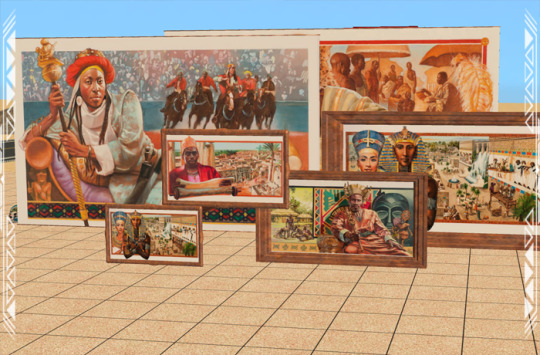
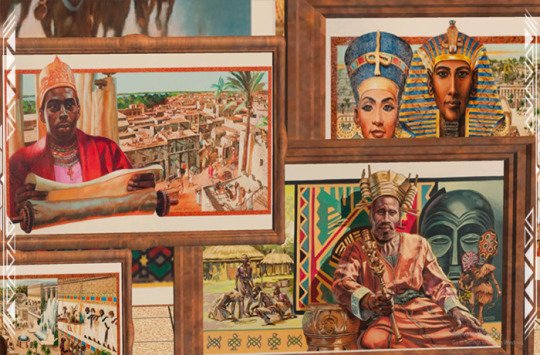
DETAILS Requires Sims 2. Requires Apartment Life for shiftability. §1K-15K | Buy > Deco > Wall Hangings Paintings are centered on 1-tile but cover more tiles than that. They come in various gallery sizes and images have been edited to fit the mesh. After purchase, their value increases by approximately 2% daily – watch out for burglars! Files with “MESH” in their name are REQUIRED. Frame recolors include EA/Maxis and yeti textures. Frame and painting recolors are merged into two files so you’ll have to take them or leave them. ITEMS Great Kings & Queens of Africa: Paintings 001-006 (92-764 poly) DOWNLOAD (choose one) from SFS | from MEGA

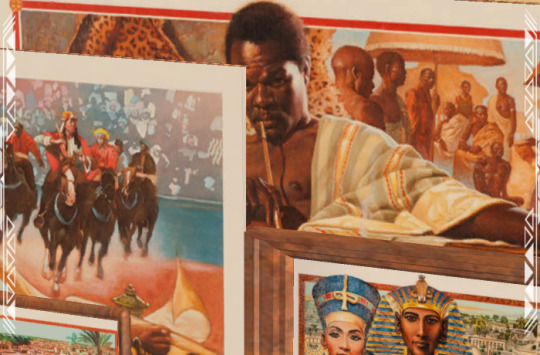
IMAGES
Akhenaton Pharaoh of Egypt (1375-1358 BC) by Barbara Higgins Bond
Alfonso I King of the Kongo (circa 1486-1543) by Carl Owens (1929-2002)
Askia Muhammaed Toure King of Songhay (1493-1529) by Leo Dillon
Benhanzin Hossu Bowelle—The King Shark (1841-1906) by Thomas Blackshear II
Cleopatra VII Queen of Egypt (69-30 BC) by Ann Marshall
Hannibal Ruler of Carthage (247-183 BC) by Charles Lilly
Hatshepsut The Ablest Queen of Far Antiquity (1503-1482 BC) by Dean Mitchell
Idris Alooma Sultan of Bornu (1580-1617) by Charles Lilly (1949-)
Ja Ja King of the Opobo (1821-1891) by Jonathan Knight
Khama III The Good King of Bechuanaland (1819-1923) by Carl Owens
Makeda Queen of Sheba (960 BC) by Debra Edgerton
Mansa Kankan Musa King of Mali (1306-1337) by Barbara Higgins Bond
Menelek II King of Kings of Abyssinia (1844-1913) by Dow Miller
Moshoeshoe King of Batsutoland (circa 1786-1870) by Jerry Pinkney
Mwana Ngana Ndumba Tembo—Ruler of the Angolan Tchokwe (1840-1880 circa) by Kenneth Calvert
Nandi Queen of Zululand (1778-1826 AD) by HM Rahsaan Fort II
Nefertari Nubian Queen of Egypt (192-1225 BC) by Steve Clay
Nehanda of Zimbabwe (1862-1898) by Lydia Thompson
Nzingha—Amazon Queen of Matambo (1582-1663) by Dorothy Carter
Osei Tutu King of Asante (circa 1650-1717) by Alfred Smith
Queen Amina of Zaria (1588-1589) by Floyd Cooper
Samory Toure The Black Napoleon of the Sudan (1830-1900) by Ezra Tucker
Shaka-King of the Zulus (1787-1828) by Paul Collins
Shamba Bolongongo African King of Peace (1600-1620) by Roy LaGrone
Sunni Ali Beer King of Songhay (circa 1442-1492) by Leo Dillon
Taharqa King of Nubia (710-664 BC) by John Thomas Biggers
Tenkamenin King of Ghana (1037-1075 AD) by Alexander Bostic
Thutmose III Pharaoh of Egypt (753-712 BC) by Antonio Wade
Tiye The Nubian Queen of Egypt (circa 1415-1340 BC) by Leonard Jenkins
Yaa Asantewa Queen of Ghana (1863-1923) by Barbara Higgins Bond CREDITS No copyright infringement intended – I own no rights to these images. Artwork and trademarks are the property of their respective creators and/or owners. If this exceeds fair use, please contact me via private message. Thanks: Simming and Sketchfab Communities. Sources: Any Color You Like (CuriousB, 2010), Beyno (Korn via BBFonts), Console Certificates (d_dgjdhh, 2019; 2011), EA/Maxis, Gyeongbokgung Sajeongjeon Painting (National Heritage Administration, 2024 via CCA; Sketchfab), Great Kings and Queens of Africa Series (Anheuser-Busch, Inc., 1975-2000; Kentake, 2016), Offuturistic Infographic (Freepik), Painting by Zdzislaw Beksinski (Sosnowski, 2018 via CCA), Yeti Metals (Shastakiss, 2017).
86 notes
·
View notes
Text



Royal Autumn 2024 Photo Challenge
Day 13: Favorite Photos of Royals with Ancestors
Photos 1 and 2; Princess Margaret and Prince Arthur of Connaught, children of Prince Arthur Duke or Connaught and Grandchildren of Queen Victoria, dressing up as distant ancestors King Edward V of England and Prince Richard Duke of York for a Tableaux
Photo 3: Drawing of King Edward V and Prince Richard done by descendant Princess Alice Grand Duchess of Hesse and By Rhine, third child of Queen Victoria
A brief history of these two brothers, most commonly known as “The Princes In The Tower” is as followed: When King Edward IV died, his eldest son Edward automatically became king but as he was only 12 years old, a regent monarch would need to rule until he became an adult. Edward and his party started to make the journey from Wales (where he was being educated to be the future king) to London but were intercepted by Richard Duke of Gloucester’s party who took custody and control of him and his party. Richard, who was King Edward IV’s brother and Edward V’s paternal uncle, was declared regent after the dying Edward IV wished it to be so and eventually had three members of Edward V’s party executed and placed Edward V in the Tower of London to have complete control over the young king. Despite pleas from mother Elizabeth Woodville, who took her remaining children into sanctuary at Westminster Abbey, her younger son Richard was eventually taken away from her and was placed in the tower with his brother. This was in May of 1483. A coronation for Edward was to be immediately planned as this is what would allow Richard to be a legal protectorate but it was repeatedly postponed by Richard himself.
In June of 1483, it was declared from parliament that all children of Edward IV and Elizabeth Woodville were illegitimate and the same with the children of brother of the former king George Duke Of Clarence (who was already dead at this time) so Richard was seen as the legitimate king and a day later acceded to the throne as Richard III. After Richard became king, the princes were taken into the inner apartments of the Tower and were seen less and less until the Autumn of 1843 when they disappeared from public view entirely. After the young princes disappearance, it was widely accepted that they were killed on the orders of their Uncle Richard and were smothered to death in their sleep, this theory is most accurate because Richard had complete access to them and men so loyal that they would do anything for their king.
In 1674, close to two hundred years later, two sets of skeletons resembling two children were found by workers who were rebuilding a staircase in the Tower. King Charles II ordered that the bones be placed in an urn marked with the children’s names on it which was located in Westminster Abbey until 1933 when it was reopened to be examined under the orders of King George V. Some animal bones were found within these two sets of children’s skeletons and since in 1933 modern DNA testing wasn’t invented yet, the tomb was closed. Further reopening the tomb and testing has been denied, so ultimately we still do not factually know if these are the true Princes in the Tower
~
#royal autumn 2024 challenge#the princes in the tower#princes in the tower#king Edward v#prince Richard#Duke or York#british royal family#brf#princess Alice#princess alice grand duchess of hesse#princess margaret of connaught#crown princess margaret of sweden#prince arthur of connaught#1800s#Victorian era#1483#king richard iii#1400s
17 notes
·
View notes
Text
ROUND ONE: PRELIMINARY ROUND

———————————————
Charles II Propaganda:
He paid more attention to dogs than politics, he loved dogs. His favorite dog breed was actually named after him; the King Charles Spaniel.
He also unbanned all of the things Cromwell had banned (I.e., Christmas, Sports, theatre, and then screwed the head of Cromwell onto Westminster abbey! (Power move tbh)
George III Propaganda:
The guy was the first king to study science as part of his education, founded and paid the cost of the Royal Academy of Arts. and he has a hard time parking his kangaroo:
I would like to have a dinner party with George Ill (from horrible histories of course)
#horrible histories#horrible histories shabby showdown#shabby showdown#shabby showdown: preliminaries
12 notes
·
View notes
Text
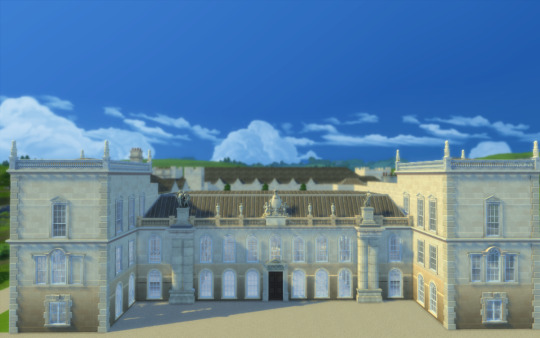

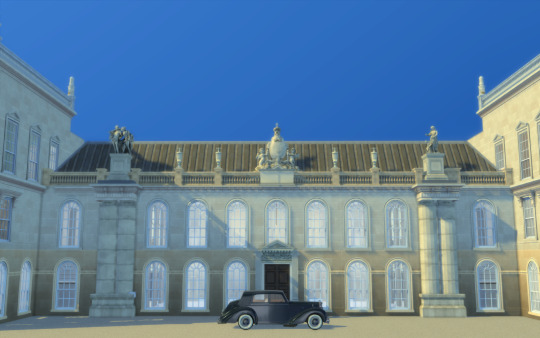



Grimsthorpe Castle
Hi guys!!
I'm sharing another grand english state!
House History: The building was originally a small castle on the crest of a ridge on the road inland from the Lincolnshire fen edge towards the Great North Road. It is said to have been begun by Gilbert de Gant, Earl of Lincoln in the early 13th century. However, he was the first and last in this creation of the Earldom of Lincoln and he died in 1156. Gilbert's heyday was the peak time of castle building in England, during the Anarchy. It is quite possible that the castle was built around 1140. However, the tower at the south-east corner of the present building is usually said to have been part of the original castle and it is known as King John's Tower. The naming of King John's tower seems to have led to a misattribution of the castle's origin to his time.
Gilbert de Gant spent much of his life in the power of the Earl of Chester and Grimsthorpe is likely to have fallen into his hands in 1156 when Gilbert died, though the title 'Earl of Lincoln' reverted to the crown. In the next creation of the earldom, in 1217, it was Ranulph de Blondeville, 4th Earl of Chester (1172–1232) who was ennobled with it. It seems that the title, if not the property was in the hands of King John during his reign; hence perhaps, the name of the tower.
During the last years of the Plantagenet kings of England, it was in the hands of Lord Lovell. He was a prominent supporter of Richard III. After Henry VII came to the throne, Lovell supported a rebellion to restore the earlier royal dynasty. The rebellion failed and Lovell's property was taken confiscated and given to a supporter of the Tudor Dynasty.[2]
The Tudor period
This grant by Henry VIII, Henry Tudor's son, to the 11th Baron Willoughby de Eresby was made in 1516, together with the hand in marriage of Maria de Salinas, a Spanish lady-in-waiting to Queen Catherine of Aragon. Their daughter Katherine inherited the title and estate on the death of her father in 1526, when she was aged just seven. In 1533, she became the fourth wife of Charles Brandon, 1st Duke of Suffolk, a close ally of Henry VIII. In 1539, Henry VIII granted Charles Suffolk the lands of the nearby suppressed Vaudey Abbey, founded in 1147, and he used its stone as building material for his new house. Suffolk set about extending and rebuilding his wife's house, and in only eighteen months it was ready for a visit in 1541 by King Henry, on his way to York to meet his nephew, James V of Scotland. In 1551, James's widow Mary of Guise also stayed at Grimsthorpe. The house stands on glacial till and it seems that the additions were hastily constructed. Substantial repairs were required later owing to the poor state of the foundations, but much of this Tudor house can still be seen today.
During Mary's reign the castle's owners, Katherine Brandon, Duchess of Suffolk (née Willoughby) and her second husband, Richard Bertie, were forced to leave it owing to their Anglican views. On Elizabeth's succeeding to the throne, they returned with their daughter, Susan, later Countess of Kent and their new son Peregrine, later the 13th Baron. He became a soldier and spent much of his time away from Grimsthorpe.
The Vanbrugh building
By 1707, when Grimsthorpe was illustrated in Britannia Illustrata, the 15th Baron Willoughby de Eresby and 3rd Earl Lindsey had rebuilt the north front of Grimsthorpe in the classical style. However, in 1715, Robert Bertie, the 16th Baron Willoughby de Eresby, employed Sir John Vanbrugh to design a Baroque front to the house to celebrate his ennoblement as the first Duke of Ancaster and Kesteven. It is Vanbrugh's last masterpiece. He also prepared designs for the reconstruction of the other three ranges of the house, but they were not carried out. His proposed elevation for the south front was in the Palladian style, which was just coming into fashion, and is quite different from all of his built designs.
The North Front of Grimsthorpe as rebuilt by Vanbrugh, drawn in 1819. Vanbrugh's Stone Hall occupies the space between the columns on both floors.
Inside, the Vanbrugh hall is monumental with stone arcades all around at two levels. Arcaded screens at each end of the hall separate the hall from staircases, much like those at Audley End House and Castle Howard. The staircase is behind the hall screen and leads to the staterooms on the first floor. The State Dining Room occupies Vanbrugh's north-east tower, with its painted ceiling lit by a Venetian window. It contains the throne used by George IV at his Coronation Banquet, and a Regency giltwood throne and footstool used by Queen Victoria in the old House of Lords. There is also a walnut and parcel gilt chair and footstool made for the use of George III at Westminster. The King James and State Drawing Rooms have been redecorated over the centuries, and contain portraits by Reynolds and Van Dyck, European furniture, and yellow Soho Tapestries woven by Joshua Morris around 1730. The South Corridor contains thrones used by Prince Albert and Edward VII, as well as the desk on which Queen Victoria signed her coronation oath. A series of rooms follows in the Tudor east range, with recessed oriel windows and ornate ceilings. The Chinese drawing room has a splendidly rich ceiling and an 18th-century fan-vaulted oriel window. The walls are hung with Chinese wallpaper depicting birds amidst bamboo. The chapel is magnificent with superb 17th-century plasterwork.
More history: https://en.wikipedia.org/wiki/Grimsthorpe_Castle


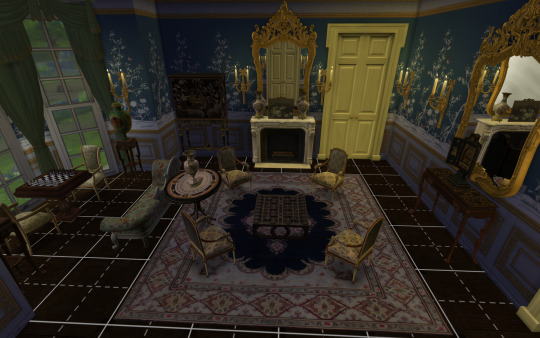

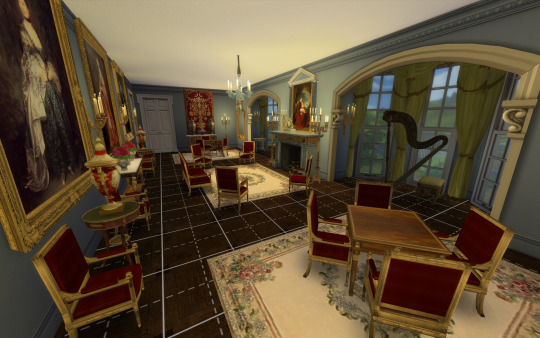

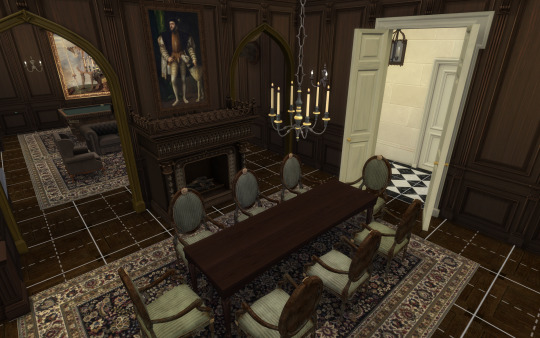


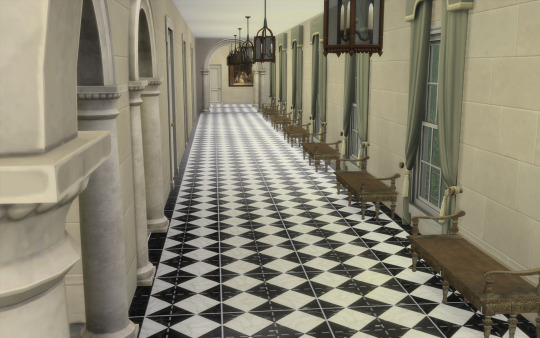

This house fits a 64x64 lot and features several impressive rooms, more than 29 bedrooms, a servants hall and several state rooms!
I only decored some of the main rooms, for you to have a glimpse of the distribution. The rest is up to you, as I have stated that I do not like interiors :P
Be warned: I did not have the floor plan for the tudor rooms, thus, the distribution is based on my own decision and can not fit the real house :P.
You will need the usual CC I use: all of Felixandre, The Jim, SYB, Anachrosims, Regal Sims, TGS, The Golden Sanctuary, Dndr recolors, etc.
Please enjoy, comment if you like it and share pictures with me if you use my creations!











DOWNLOAD (Early acces: June 30) https://www.patreon.com/posts/grimsthorpe-101891128
#sims 4 architecture#sims 4 build#sims4#sims4play#sims 4 screenshots#sims 4 historical#sims4building#sims4palace#sims 4 royalty#ts4 download#ts4#ts4 gameplay#ts4 simblr#ts4cc#ts4 legacy#sims 4 gameplay#sims 4 legacy#sims 4 cc#thesims4#sims 4#the sims 4#sims 4 aesthetic#ts4 cc#english manor
41 notes
·
View notes
Text



David Stewart, 1st Duke of Rothesay and heir to the throne of Scotland died on March 26th 1402.
In all the long history of the Stewart dynasty there are many tragic figures such as Mary, Queen of Scots and King Charles I, but surely there can be no more hapless and lamentable bearer of the name than the first prince to ever carry the title of the Duke of Rothesay.
David Stewart was the heir to the throne of Scotland at the end of the 14th century until he lost his claim to kingship, and his life, at the behest of his own uncle. His death occurred in the strangest of circumstances in this week of 1402.
t was a time of great jostling for power within the Stewart clan and their fellow Scottish aristocrats. David was born on or around October 24th, 1378, as the son of John, Earl of Carrick, the heir to the Scottish throne, and his wife Countess Anabella nee Drummond. On becoming King he took the name Robert as John and it’s association with the Balliol's’ was considered unlucky, the third to use the name.
Robert III had been kicked by a horse two years before his coronation and as well as physical injury he suffered from melancholia, or depression as we know it.
His younger brother, confusingly also called Robert, was the Earl of Fife who had assumed the Lieutenancy and taken control of the governance of Scotland in the early part of Robert III’s reign.
Both Fife and 19-year-old David Stewart were created Dukes, the first in Scotland, in 1398 after David was knighted at the Great Tournament of Edinburgh arranged by his mother. Fife became Duke of Albany and David became Duke of Rothesay, the title which has passed down to the heirs to the Scottish throne – Prince Charles is the current holder.
Albany’s grip on power had seemed secure at first but as her husband’s health deteriorated, Queen Anabella began to take more control, and she also pushed the cause of her son David as the heir, arranging for him to become the Lieutenant in 1399. The problem was David’s personality – he was a self-indulgent wild child, who grew increasingly debauched as his teens wore on.
He was also arrogant to a fault, and despite being engaged and probably married to Elizabeth Dunbar, daughter of the Earl of March, he decided for dynastic reasons to marry Mary Douglas, daughter of the hugely powerful 3rd earl of Douglas, known as Archibald the Grim.
The Earl of March was furious and switched allegiance to King Henry IV of England who promptly invaded Scotland but had to go home when Edinburgh Castle thwarted his siege. Poor David got the blame for the invasion and his already sagging popularity hit a new low.
When both Archibald the Grim and his mother died in 1401, the Duke of Rothesay was in a very vulnerable position as his uncle Albany moved to complete his control of the kingdom. Albany was assisted in this by Archibald, 4th Earl of Douglas who greatly disliked Rothesay.
Early in 1402, Albany moved to consolidate his power by conspiring with Archibald Douglas to have his nephew David arrested and imprisoned in Albany’s Falkland Palace in Fife on trumped up charges.
It was there that David died on March 26, 1402, most probably from starvation. Whether he was murdered or not is unknown. The official verdict was that Rothesay died of natural causes but the circumstances said otherwise.
His father, the virtually insane King Robert III, presided over a council of enquiry and had to put his name to a document which exonerated Albany and Douglas.
The King wrote: “We consider as excused the aforementioned Robert and Archibald, and anyone who took part in this affair with them, that is any who arrested, detained, guarded, gave them advice, and all others who gave them counsel, help or support, or executed their order or command in any way whatsoever, and in our said council we openly and publicly declared, pronounced and determined definitively and by the tenor of this our present document declare, pronounce, and by this definitive sentence judge them and each of them to be innocent, harmless, blameless, quit, free and immune completely in all respects.”
Robert even ordered the end to malignant rumours: “Wherefore we strictly order and command all and singular our subjects, of whatever standing or condition they be, that they do not slander the said Robert and Archibald and their participants, accomplices or adherents in this deed, as aforesaid, by word or action, nor murmur against them in any way whereby their good reputation is hurt or any prejudice is generated, under all penalty which may be applicable hereafter in any way by law.”
The opposition silenced, Albany was in complete control and remained so even after Robert III died in 1406, when David Stewart’s younger brother James became King. But having fled from the marauding Douglases, young James was at that time in the custody of the English court and would remain an exile for 18 years.
How much pressure was put on the King at this time is not known, however as insane as he was, he decided to send his other son, Prince James, aged only about 1, to France for safety. As you know from last Tuesday’s post, his ship was boarded by pirates and he ended up as a “guest” of the English, for the best part of 20 years.
When Robert III heard of his son's capture, he became even more depressed. He refused any food and died within a few days on April 4th, 1406.
Robert asked to be buried under a dunghill with the epitaph: Here lies the worst of Kings and the most miserable of men as he did not consider himself worthy of the honour. He ended up being buried in Paisley Abbey.
David Duke of Rothesay is said to have been buried at Lindores a Tironensian abbey on the outskirts of Newburgh in Fife, which never survived the vandalism of the Scottish Reformation.
Pics are Falkland Palace, then and now, and Lindores Abbey ruins.
21 notes
·
View notes
Text
This left a mark: Christian Dior & Saks partnered for Light up the NYC Night for Christmas 2023
youtube
youtube
youtube
No doubt "DIOR Contract" was at the top of the 2017 RMM- DIANA 2.0 vision board & megxit manifesto. In other words: Sparry's 'honey do' for MeMe list: Meet Beyonce (on yellow carpet)✔ Disney (princess) gig✔. oh to be a fly on a Cali wall after that Dior ANNOUNCEMENT: guttural moans & tears for weeks! 😬
Dior in 2018: MEgain's inappropriate Dior cocktail dress w/pinwheel headpiece for 1st balcony appearance. She also appeared to lose a tooth during the reception.

2019-"Christening"

2021 & 2022 New York City


2022 Jubilee as Wallis Simpson & 2023 Sparry



A word to the wise and to the Meghans: The REAL Santa knows whose on the MARKLED List.

Play stupid games and MARKLE yourselves!

I'll buy that Jill Smoller (formerly Gina) badgered Dior on behalf of MEgain, but no way would Dior sully their brand with the toxic, mentally unstable, over seas royals who can't be bothered to iron 🙄
"Oh & I took FRENCH for 8 years in high school or was it 4 years?" 😉
"...but but I'm not a model, I'm just a mom. Thankfully Sparry was here to coach me that I can be both. I wonder how he became so wise?" Variety 2022
Please follow the link to subscribe to "Woman Behind Kate" & LIKE👍
Princess Diana 2.0 caught in the act
youtube
Sparry, YOU MARKLED yourselves. Stop blaming the BRF for your failures to launch.

Princess Diana 2.0 Tom Bower
The Sun: What is the history between Dior and the royal family?
December 12, 2023 || Born in 1905, Christian Dior, the fashion designer, climbed the ranks of several Parisian fashion houses before establishing his own establishment in 1946.
One of the early royal admirers of the designer was Princess Margaret, the sister of Queen Elizabeth II.
She became a client of the fashion house and one of Dior's most famous designs, the "Margaret Dress," was named after her.
Queen Elizabeth II also shared a close connection with Dior.
She appointed Doir to design her Coronation gown for the crowning ceremony in 1953.
The gown, famously called the "Hartnell Dress," was a collaboration between Dior and British couturier Sir Norman Hartnell.
Over the years, various royal family members have continued to wear Dior creations for public appearances.
Dior dressed Prince Harry for King Charles' coronation in May 2023 - as the royal forwent wearing a military uniform.
Shortly after the coronation ceremony, Dior took to its social media to reveal Kim Jones was the designer behind the suit.
"Tailoring fit for royalty. Dior is honoured to have dressed Prince Harry, Duke of Sussex, for the coronation of King Charles III in a custom design by Kim Jones," the brand wrote on Instagram.
"Seen arriving at Westminster Abbey, gain an insight into the savoir-faire of his three-piece suit next," it added.
Why was it speculated that Meghan Markle would have a deal with Dior?
In June 2023, it was reported that Meghan was in talks about taking on a deal with Dior.
Following the cancellation of her Spotify podcast after just one season, there was widespread speculation that the Duchess of Sussex was poised for a new role with the French fashion house.
Meghan has worn Dior several times throughout her time as a working royal, including at the late Queen Elizabeth's funeral in September 2022.
However, sources close to the Royals said no contract had been inked.
Dior also expressed its surprise and confusion when the idea of a deal was initially brought up.
A source told the Telegraph: "The Duchess of Sussex is not in talks to sign a deal with Dior.
"There is no truth to the claims that she will partner with the French fashion house,"
A Dior insider said its team was "nonplussed as to how the story came about".
Who became 'the Duchess of Dior' in 2023?
Meghan lost out on the opportunity of a lucrative Dior job to a Kate Middleton actress.
It was revealed in November 2023, that Meg Bellamy, 21, who plays a young Kate Middleton in season six of the hit royal drama The Crown is to be the new face of Dior.
An insider told The Daily Mail: "They have been queuing up for Meg, she is playing the most famous woman in the world in a globally famous television drama, so many labels and brands want some of that.
"She is a total unknown, but she is being treated like Kate, an A-list princess."
What deals and contracts does Meghan Markle have?
After leaving the royal family and their royal duties, Prince Harry and Meghan vowed to become financially independent.
It was reported that the couple would support themselves through Prince Harry's $10 million inheritance from his mother, Princess Diana.
With the world eager to know their story, lucrative million-dollar deals started rolling in from AppleTV, Netflix, and Spotify.
The couple signed a deal with Netflix through their production company, Archewell Productions, with a hefty payment of $100 million for multiple projects.
They have since released one documentary, Harry and Meghan.
Their upcoming documentary series titled, Heart of Invictus, is in the works.
While their third documentary is to be shot in South Africa, the Sussexes are also planning to delve into the rom-com genre with the streaming giant
In June 2023, the couple made headlines when it was reported that their 25-million-dollar deal with Spotify had ended.
According to Rolling Stone, the couple would pay back a portion of their deal money and look for another company to produce podcasts with.
In a joint statement, they said: "Spotify and Archewell Audio have mutually agreed to part ways and are proud of the series we made together."
Royal biographer Tom Bower believes that the couple's "joint ventures are falling apart" and that Meghan is finding it difficult to sell her brand.
"They're beginning to taste the medicine that they handed out after the Oprah interview and they're finding it very very hard to keep their brand reputable," Bower told new magazine.
"They're constantly having to defend themselves and grasping at opportunities that don't exist anymore."
#christian dior#2023 Losers#megxit#Duchess of Narsussex#markled#rejected#tom bower#kinsey schofield#fashion influencer#saks fifth avenue#christmas 2023#Woman Behind Kate#TheWorking Team#guttural#French#nyc#Princess Diana 2.0#Youtube
41 notes
·
View notes
Note
can u give me a guide to the six idiots :33 like maybe with a picture of them n their names n who they play in the Big Three shows :33 pwetty peesse :33
UM YES!?
ok, you saw me earlier trying to format all the images so it's gonna be mostly my (ehhhh) descriptions of the characters and you gotta guess what they look like 😈
Ben Willbond

Yonderland:
Elder Vex (above): the one who says Deb-beh and has the coziest looking outfit I NEED IT RN PLZ and the Tom Cardy- esque hair and earring
Nick: the stick. Grumpy all the time cuz he's a stick >:(. Is also a portal between dimensions but whatevs
Horrible Histories
Mike Peabody :historical news reporter that wishes he were anywhere but here rn
King Henry, Alexander the Great: SkINy MaNdRiA, excellent hair, sniffed a guy
Ghosts
The captain: AKA James, makes a lotta noises, if you ever hear me going weeeahhhhhuuuueeeaaaaaahhhh, I'm referencing him, the gay one<3
Martha Howe-Douglas!

Yonderland!!
Debbie.
Debbie's evil twin sister (bossy boobs)
I just googled it: Rita, the Negatus simp AKA us, the demon that looks like how female animals are protrayed in Barbie movies
Horrible Histories!!!
Boudica (look up the song, it's rlly good), Cleopatra, every female historical figure
Pirate lady....<33333
Ghosts!
Lady Button (present day): Old disgruntled lady that pouts all the time and falls out of windows
Lady Button (flashback)
Mathew Baynton!!!

Yonderland!!!
Oracle: weird blue blob guy, Nigel, Darling
Nanny la roo: NUM NUMS!!!! - nanny that is also a kangaroo
Admiral Anous: Voldemort mf I hate him bc he hates Negatus>:(
Elder Choop: Croissant hair mf, says, "IDK WHY DON'T WE ASK UR MUM??"
Le Fox: French
THE BIRRDDDDD: AKA Thomas Payne, Batman but cooler
Oh yeah, and Elf: the elf shaped one, full name: Grintallin Gobscrew Crotell Fashanu F’naw Goplatz Holla-Holla, has multiple wives apparently and is in debt to the mob
Horible Histories (look all of them up, they are all hot)
Dick Turpin: play the song >:333, shot not one but two men dead!
D.I. Bones: the whakkus bonkkused
King Charles II: absolute party-er
Ghosts
Thomas Thorne, shot, dead! Absolute poetic simp for Allison, drowned himself in the lake ;( -cannot drown-
Jim Howik!!!

Yonderland
Elder Pressley: looks like Elvis, eats christmas tree ornaments
Crone: A sLaPper *wink wink*, has apparently gotten with everyone, goes eeeerrrrrrrrrrr all the time- sounds like a doorhinge, she is amazing
Neil: lhe most normal of the demons probably
Horrible Histories
A SHOUTY MAN!!! :does all the infomercials, will try to sell you piss
King George VI (above) : "oh yesss, dad's dead, I'm king..."
King Richard III: a sweet little guy<3 -according to the song, get's attacked by whasp
Ghosts
Pat Butcher: Greatest DJ in the AAARRREEEEEUHHHHH, killed by a child, AKA Pete in the American version
Larry Rickard

Yonderland
Detective Mounteback: very dumb detective with very large hat
Elder Ho Tan: trans Icon, doesn't like loud noises, absolute baby<3
Sue: above, the lady with the gun from the episode I showed you
Horrible Histories
Bob Hale: weather report, needs a hellicopter and a nice cup of tea, basically Bill Wurtz
Lol knight with shit on head, Aztec guy, George III friend who slays so hard; "ConGRatu-VerY-LaTiOns your... *MAgEsTy*"
Ghosts
Humphrey: keeps getting left on roofs and shelves, does NOT know French smh
Robin: 5,000 yo ghosts, once saw a cool butterfly, KNOWS FRENCH! Got stuck by lightning and now he can turn on lights
and finally... the moment you've been waiting for...
Simon Farnaby!!!

Yonderland!!!
Negatus<333: Silly guy try to take over Yonderland but is just a lil guy, has an evil lair, uses The Font of Orris (cauldron thing that lets you see everything) as a hot tub, get's bullied by all the other overlords, wears pjs with houses on them.
Elder Flowers!!!: Long hair and lack of shirt, vegetarian hippie of the group, wants his clothes to be veGONE, "all you need is love, brothers... oh, and food"
Horrible Histories
Emperor Caligula: the wakkus bonkkus guy
Marcus Licinius Crassus: Knockoff Bassline Junkie song
Ghosts:
Jullian!!!: Died conducting an affair with his secretary!!!, is eternally sorta drunk, does the hand thing, only ghost that can interact with stuff, makes silly EEERREREEEEE noise when he's trying to move something, his name is Trevor in the American version, sad when there's no porn on da TV ;(, has no pants BTW
Thanks for coming to my TEDTALK!!!
Lemme know if I missed anything!

35 notes
·
View notes
Text
Masterpost: Royal Authors
This is a text version of the original list I curated, which can be found here. The royals are listed chronologically based on their first name (not title). The books are listed with the oldest book first & most recently published book last.
Some of the mentioned people have published books or lent out their names for books as private citizens; this post & the original list only cover royal members & books published under their royal title. This means that some books & some people have been excluded due to not falling under those criteria.
Note: Some of the following links are affiliate links, which means I earn a commission on every purchase. This does not affect the price you pay.
Princess Akiko of Mikasa
Reconsidering early modern Yamato-e: perspectives from Japan, the UK, and the USA (2013)
Japan: Courts and Culture (2020)
Princess Alice, Duchess of Gloucester
The Memoirs of Princess Alice Duchess of Gloucester (1983)
Memories of Ninety Years (1991)
Catherine, Princess of Wales
Hold Still (2021)
Puzzles for Spies: The brand-new puzzle book from GCHQ (2022)
King Charles III
The Old Man of Lochnagar (1980)
Tomorrow is Too Late - A Celebration of Our Wildlife Heritage (1990) (with Sir David Attenborough, among others)
The Prince's Choice: A Personal Selection from Shakespeare by the Prince of Wales (1995)
Harmony: A New Way of Looking at Our World (2010)
Harmony: A New Way of Looking at Our World - Children's Edition
One Is Deeply Concerned: The Prince Charles Letters, 1969-2011 (2011)
The Prince's Speech: On the Future of Food (2012)
The list is too long; that man puts his name on literally everything. Check the page for more.
Princess Christina, Mrs Magnuson
Days at Drottningholm (2016)
Diana, Princess of Wales
British Sign Language: A Beginner's Guide (1988)
PEOPLE OF THE 90's: In Aid of the Malcolm Sargent Cancer Fund for Children (1995)
Hannah Riddell: An Englishwoman in Japan (1996)
Head Injury: A Practical Guide (1997)
King Edward VIII, Duke of Windsor
Launch! A Life-Boat Book (1932)
A King's Story: The Memoirs of the Duke of Windsor (1951)
The Crown and the People, 1902-1953 (1953)
Prince Edward, Duke of Kent
Jackie Stewart's Principles of Performance Driving (1986)
Australia Bound!: Story of West Country Connections, 1688-1888 (1988)
Deep into Blue Holes: The Story of The Andros Project (1989)
The Institution of Industrial Managers: A History 1931-1991 (1991)
The Story of E. H. Shepard: The Man Who Drew Pooh (2000)
Tribal Odyssey: A Photographic Journey Among Tribes (2000)
Chasin' the Sound: Tales and tunes from the career of Pipe Major Brian B Heriot, Scots Guards (2016)
A Royal Life (2022) (his memoir)
One Crew: The RNLI's Official 200-Year History (2024)
Queen Elizabeth, The Queen Mother
The Country Life Book of Queen Elizabeth The Queen Mother (1978) (actually by Charles & Godfrey Talbot, not her)
Henrik, Prince Consort
Fit for a Royal Dane: Gastronomic Views and Recipes of Prince Henrik (2002)
Meghan, Duchess of Sussex
Together: Our Community Cookbook (2018)
Princess Michael of Kent
Crowned in a Far Country: Portraits of Eight Royal Brides (1986)
Cupid and the King: Five Royal Paramours (1991)
The Serpent and the Moon: Two Rivals for the Love of a Renaissance King (2004)
A Cheetah's Tale (2017)
Princess Märtha Louise
Why Kings and Queens Don't Wear Crowns (2004)
The Spiritual Password: Learn to Unlock Your Spiritual Power (2014)
Emperor Naruhito
Costume at Castle Howard (1975)
The Thames and I: A Memoir of Two Years at Oxford (1993; 2006; 2019)
Queen Noor
Art of Jordan: Treasures from an Ancient Land (1991)
Landmines and Human Security: International Politics and War's Hidden Legacy
Leadership and the United Nations: The International Leadership Series (2003)
Leap of Faith: Memoirs of an Unexpected Life (2003)
Breaking Ground: From Landmines to Grapevines, One Woman's Mission to Heal the World: Transforming Mines to Vines (2020)
Prince Philip, Duke of Edinburgh
The Duke of Edinburgh's World Tour 1956-1957 (1957)
Selected Speeches 1948-1955 (1957)
Prince Philip speaks: 1956-1959 (1960)
Environmental Revolution: Speeches on Conservation, 1962-77 (1978)
Men, Machines and Sacred Cows (1984)
Down to Earth: Speeches and Writings of His Royal Highness Prince Philip, Duke of Edinburgh, on the Relationship of Man With His Environment (1988)
Survival or Extinction: A Christian Attitude to the Environment (1989)
The list is too long. Check the page for more.
Queen Rania
The Sandwich Swap (2010)
Prince William, Prince of Wales
Blown Away: From Drug Dealer to Life Bringer (2022)
Puzzles for Spies: The brand-new puzzle book from GCHQ (2022)
Earthshot: How to Save Our Planet (2021)
The Earthshot Prize: A Handbook for Dreamers and Thinkers: Solutions to Repair our Planet (2023)
(this post & the original list is a work in progress & will be updated whenever "new" books come on my radar)
#royal watching#literature#affiliate links#british royal family#japanese imperial family#swedish royal family#danish royal family#norwegian royal family#jordanian royal family
9 notes
·
View notes
Text


The solid silver hilt of the sword gifted to Bonnie Prince Charlie by the 3rd Duke of Perth in 1739 - BENEDICT JOHNSON
HISTORY
Sword of Bonnie Prince Charlie returns to Scotland 🏴
The weapon of the leader of the 1745 Jacobite rebellion will go on display at the Perth Museum
————————————————————————
Jack Blackburn, History Correspondent
Monday October 23 2023, 12.01am, The Times
It belonged to Scotland’s great Jacobite hope, but it never made it to these islands. Now, the sword of Bonnie Prince Charlie is finally making its way to Scotland.
However, while it was made for revolution, it will be used for the much more peaceful purpose of opening a new museum. The Perth Museum is the result of local and national funding and will also become the new home of the Stone of Destiny, upon which the King was crowned in May.
The museum will aim to tell the story of its city, which was once considered the capital of Scotland, and has played a major role in the country’s history, both modern and ancient. Perthshire is the home of the Stone of Destiny, also known as the Stone of Scone after the place where it was held. The sword will be free to view.

The sword was made by a Perthshire craftsman named James Brown - BENEDICT JOHNSON
At the forefront of Perth’s modern history is its connections to the Jacobite rebels including Bonnie Prince Charlie, a Jacobite pretender of the 18th century who some would have called Charles III. He was the heir of the deposed line of James II. His rebellion in 1745 began in Scotland but ultimately foundered at the Battle of Culloden, ending his hopes of taking the throne.
His sword was given to him by the 3rd Duke of Perth, after it had been made by a local craftsman called James Brown. A solid-silver hilted broadsword, it was gifted to Charlie when he was in exile in Rome. This took place in 1739, but it seems that he did not take it with him on his ill-fated rebellion. The museum declares that this will be the first time the sword has returned to Scotland since it was made. It is the first time it has been displayed.

A Jacobite wine glass that bears the Duke of Perth’s family motto, “gang warily” - JULIE HOWDEN
Alongside this is a significant Jacobite wine glass that bears the Duke of Perth’s family motto, “gang warily”. The two headline items will be displayed alongside other Jacobite artefacts, including a rare star targe, also known as a Highland Shield.
“We are thrilled to be able to publicly display these two significant pieces of Jacobite history for the first time,” JP Reid from Culture Perth and Kinross, said. “Perthshire sits at the heart of the Jacobite story: the scene of large-scale pitched battles like Killiecrankie and Sheriffmuir, besieged homes, scorched-earth warfare and warring kinsfolk.”
The Perth Museum has undergone a £27 million transformation from what was the City Hall. It was funded by the Tay Cities Deal and Perth and Kinross Council, but it also received £10 million from the UK government.
THETIMES.CO.UK
22 notes
·
View notes
Text
CRACKPOT THEORY: PAPA LIBA WAS BOTH PORTIER DIVIN AND MAITRE DES CARREFOURS
Maitre Carrefour might not have split off from Papa Legba until the mid 19th century or later, which would explain the absence of Maitre Carrefour in the historical record of New Orleans.
This is a reissue of an article that was originally titled “CRACKPOT THEORY: PAPA LEBAT WAS BOTH ATIBON LEGBA AND MAITRE CARREFOUR”. The original thesis made little sense; in order to be true, ‘Maitre Carrefour’ would have had to have split off from ‘Papa Legba’, then merged back with him to create Papa Liba (“Papa Lébat” / “Papa La Bas”). It is more reasonable to argue that Papa Liba was both ‘portier divin’ and ‘maitre des carrefours’, either because he predates the existence of Maitre Carrefour or because Maitre Carrefour was never transmitted to New Orleans. If true, Papa Liba captures an earlier state of Papa Legba that is closer to Legba of West African Vodun. Additionally, I claimed that the Petro rite is named after the maroon leader Don Pedro, which is probably not historically accurate. This would imply that the history of the Petro rite is brief, shortly predating Bwa Kayiman by a mere two decades. Such a notion makes little sense and requires a revision. Finally, I have decided to change my preferred nomenclature: Papa Lébat → Papa Liba.
The Rada and Petwo rites feature prominently in Haitian Vodou. They are often positioned as counterparts, with Andre Pierre describing Rada as “civilian” and Petwo as “military”[1]. This rivalry may reflect the two dominant ethnic groups of the late 18th century: the ‘Creoles’ and the ‘Congos’[2]. ‘Creoles’ describes an older generation of slaves, who had been born on the Island and descend from the Arada (Aja-Fon). ‘Congos’ describes a younger generation of slaves from western Central Africa[3]. From these two groups come the founders of the Rada and Petwo rites respectively.
Most of the 21 rites of the Sèvis Ginen are named after African tribes. The Rada rite derives its name from Arada, a West African tribe that was a major source for slaves sent to Haiti[4]. However, the Petwo rite deviates from this trend. Previously, I claimed that the Petwo rite derives its name from the maroon leader Don Pedro (Jean Petro, Dan Petwo, Dan Petro), but such claim is dubious. Don Pedro appears to have assumed the name of the warrior king Pedro III, as the maroon leader was of Kongo descent[5]. To be historically accurate, the Petwo rite does not derive its name from the maroon leader, but the veneration of King Pedro III.
The Petwo rite is a product of Haitian syncretism that merges elements of Kongo origin with those indigenous to Haiti[6]. Within the Petwo pantheon are the Simbi lwa, which are Kongo in origin. Alongside them are Maitre Carrefour and Erzulie Dantor, who are not derived from the Kongo, but serve as Petwo counterparts to the Rada lwa Atibon Legba and Erzulie Freda.
Previously, I described historical documents pertaining to the colonial precursors of the Rada and Petwo rites. There is historical evidence that Marie Laveau incorporated elements of this Rada prototype into her sect of Voudou.
Several deities in the pantheon of New Orleans Voodoo have counterparts in the Rada rite (Rite Arada), as described by Milo Marcelin[7]:
Papa Liba (Laba) → Atibon Legba
Monsieur D’Embarras* → Damballah Oueddo
Miché Agoussou (Yon Sue) → Agassou Gnenin
Simbé → Papa Simbi
*Some theorize that Monsieur Danny (Daniel Blanc) might be derived from Damballah Oueddo; however, Daniel Blanc might be derived from a different divine serpent, as he was identified with Saint Michael instead of Saint Patrick.
“Grand Zombi” might be derived from Jan Zonbi or Captain Zombi. “Assonquer” might be derived from Ossangne (Osany). “Joe Feraille” might be derived from Ogou Feraille. “Charlo” might be derived from Chal Ogou (Charles Ogou)**.
**Rather than Chal Ogou, “Charlo” might be derived from Ti Chal La Kwa (Ti-Charles la Croix). Ti Chal La Kwa is not listed in Milo Marcelin’s or Milo Rigaud’s lists of lwa, let alone the Rada rite. Instead, he belongs to the Gede rite[26].
Marie Laveau would sing a song for St. Peter, who was identified with Papa Liba (“Laba”)[8]:
“Marie Laveau…even taught her a Voodoo song. It went like this:
St. Peter, St. Peter, open the door,
I’m callin’ you, come to me!
St. Peter, St. Peter, open the door …
“That’s all I can remember. Marie Laveau used to call St. Peter somethin’ like ‘Laba.’ She called St. Michael ‘Daniel Blanc,’ and St. Anthony ‘Yon Sue.’”
The description matches a Haitian song sung for Atibon Legba[9], who was also identified with St. Peter[10].
What is less clear is whether the Petwo prototype was also incorporated.
Marie Laveau had altars set up for “good work” and “bad work”, described like so[11][12]:
Raoul enjoyed describing the home of the Laveaus. According to him there was an altar for “good luck and good work” in the front room. It was covered with a white cloth and held a statue of the Virgin and one of Saint Peter. Raoul recalled one of another saint, a Saint Marron, who, he explained, “was a colored saint white people don’t know nothing about. Even the priests ain’t never heard of him ’cause he’s a real hoodoo saint.”
But this altar in the front room was secondary to another at the back of the house, Raoul believed. “In the back,” he said, “was the altar for bad work. On it was statues of a bear, a tiger, a lion and a wolf. Right in the middle was a big carved box with a snake inside it. That box and snake had been sent to Marie Laveau from Africa and that snake was the devil. I know that’s true, ‘cause I seen it myself, me.”
If it is not a fabrication by Tallant, the inclusion of the snake is similar to descriptions of precolonial Haitian Vodou.
Still, I have struggled to find definitive evidence that the Petwo or Gede prototypes (i.e., “Don Pedro sect” & “cult of the dead”) were transmitted to New Orleans. Interestingly, the name Don Pedro appears in the historical record of New Orleans, assumed by a self-described “King of Voudou”[13][14]. It is unclear whether this “Pedro, Prince of Darkness” had any relation to the Petwo rite , or not.
Was the Don Pedro sect strong enough to take root in New Orleans?
If so, how and which elements were incorporated?
To what extent did the Don Pedro sect resemble the modern Petwo rite?
These are all questions I do not have answers to.
The following is purely speculation, but I hypothesize that Papa Liba of New Orleans Voodoo was both portier divin and maitre des carrefours.
This is because I do not think the split between Papa Legba and Maitre Carrefour was codified until the mid 19th century or later; that is, after the Haitian Revolution and subsequent migration wave to New Orleans.
The Haitian lwa Papa Legba is derived from Fon Legba; Fon Legba is himself derived from the Yoruba orisa Esu[15].
The distinction between “crossroads” and “gateways” is an illusion, as the Yoruba word orita can refer to both types of intermediary space[16]. As gods of the orita, Esu and Legba are associated with both entrances and crossroads.
Descriptions of Papa Legba as guardian of the crossroads appear in texts from the early 20th century.
From Milo Marcelin[17]:
“Papa Legba ou Atibon-Legba est le dieu des portes, le maître des carrefours et des croisées de chemins et le protecteur des maisons. En vertu de ces différentes fonctions, il est invoqué sous les noms de « Legba-nan- bayè » (Legba des barrières), de « Legba-calfou » (Legba des carrefours) ou « Grand chemin », de « Legba Mait' bitation » ou « Legba Maiť habitation ». En tant que dieu qui sait toutes choses, il porte l'épithète d'Avadra...”
“...Pour invoquer Legba, l'officiant se sert d'une pierre qu'il place sur l'autel. Ensuite il trace un dessin symbolique (vèvè) sur le sol et récite la prière suivante :
Par pouvoir saint Antoine, au nom de M. Avadra Boroy, de Legba-Atibon, le maître des carrefours et des grands chemins, de Legba-Kataroulo, de vaillant Legba, de Legba-Sé, de Alegba-Si, de Legba-Bois, de Legba-Zinchent, de Legba- Caye, de Legba-Misé-ba, de Legba-Clairondé, de Legba-Signangnon, des sept Legba-Kataroulo, vieux, vieux, vieux Legba. Ago, Agoé, Angola.”
TRANSLATION
“Papa Legba or Atibon-Legba is the god of doors, the master of crossroads and the protector of houses. By virtue of these different functions, he is invoke under the names of “Legba-nan- bayè” (Legba of the Barriers), “Legba-calfou” (Legba of the Crossroads) or “Grand chemin”, “Legba Mait’ bitation” or “Legba Mait’ habitation”. As the god who knows all things, he bears the epithet of “Avadra”...”
“...To invoke Legba, the officiant uses a stone that he places on the altar. Then he traces a symbolic drawing (vèvè) on the ground and recites the following prayer:
By the power of Saint Anthony, in the name of Mr. Avadra Boroy, of Legba-Atibon, the master of the crossroads and great paths, of Legba-Kataroulo, of valiant Legba, of Legba-Sé, of Alegba-Si, of Legba-Bois, of Legba-Zinchent, of Legba-Caye, of Legba-Misé-ba, of Legba-Clairondé, of Legba-Signangnon, of the seven Legba-Kataroulo, old, old, old Legba. Ago, Agoé, Angola.”
From Milo Rigaud[18]:
LEGBA. Papa Legba. Le mystère-Principe identifié au soleil et l'Est cosmique. S'identifie aussi au poteau rituel. Legba est le gardien des portes de I'astral; c'est lui qui garde < la barrière > ; aussi est-il Maître Grand-Chemin comme gardien des passages, attribution qui lui vaut d'etre, en meme temps, Maître-Carrefour ou le mystère de tous les croisements de route. Le syncrétisme religieux l'assimile au calvaire. Dans le panthéon voudoo, il est placé entre ses deux femmes: T-Sih-Lah We-Do et Ai-Da We-Do. Legba est le Christ voudoo ; il est placé au centre de toutes les races, ce qui signifie qu'il est < mulâtre >. Sa couleur est le blanc, tandis que Aida Wedo porte un drapeau d'azur, et Tsihlah un drapeau rouge. Synthèse des points cardinaux.
TRANSLATION:
LEGBA: Papa Legba. The Principle mystère identified with the Sun and the cosmic East. He is also identified with the ritual poteau. Legba is the guardian of the astral doors; it is he who guards “the gates”; he is also Maître Grand-Chemin as guardian of passages, an attribution which makes him at the same time, Maître-Carrefour or the mystère of all intersections of paths. The religious syncretism assimilates him with Cavalry. In the Vodou pantheon, he is placed between his two wives: T-Sih-Lah We-Do and Ai-Da We-Do. Legba is the Vodou Christ; he is placed at the center of all races, which means that he is a “mulatto”. His color is white, while Aida Wedo carries a blue flag, and Tsihlah a red flag. Synthesis of the cardinal points.
From Alfred Metraux[19]:
“Master of the mystic ‘barrier’ which divides men from spirits, Legba is also the guardian of the gates and of the fences which surround houses and, by extension, he is the protector of the home. In this latter rôle he is invoked under the name of Maît’-bitasyon (Master of the habitation). He is also the god of roads and paths. As ‘Master of the Crossroads’ he is the god of every parting of the way – a favourite haunt of evil spirits and propitious to magic devices; and it is at crossroads that he receives the homage of sorcerers and presides over their incantations and spells. Many magic formulae begin with the words ‘By thy power, Master of Crossroads.’” (p.124)
“Arriving at a crossroads we halted so that we could pay homage to the patron spirit of crossroads–Legba. The god’s emblem was quickly traced out in flour in the middle of a clearing, a small fire was lit and into it each in turn made libations and offerings. The hunsi sang hymns to Legba, and the standard-bearers, having done the rounds of the fire, kissed the earth. Legba chose this moment to possess a girl who was still almost a child…” (p. 314)
“The religious ceremonies called manger-morts include offerings to the dead of food cooked without salt and prepared entirely by men…After prayers and appeals addressed to the ancestors and the unknown dead who have died by steel, fire or water, the père-savane or head of the family knocks three times on the door and goes in. He brings out a calabash full of various foodstuffs which he distributes among the children of the household…Another calabash is placed at a crossroads for Legba…” (p. 362)
“The grand-master of charms and sorceries is Legba-petro, invoked under the name of Maître-Carrefour, or simply Carrefour. Indeed, crossroads are favourite sites for the ‘works’ of magicians, handfuls of earth taken from them are an ingredient of many beneficent or harmful spells…” (p. 366)
“In Fon mythology Legba, as interpreter to the gods, fulfills a function of primordial importance in the whole system of religion. He alone can deliver messages of the gods in human language and interpret their will. He is also the god of destiny, he who presides over divination with palm-nuts or shells. As intermediary between human beings and the divine pantheon and receives the first offerings. He is also a phallic god, represented in front of every house by a little mound of earth out of which sprouts a phallus made of iron or wood. Out of this most potent of gods the Voodooists have made an impotent old man who walks on crutches. Recalling vaguely his rôle as divine messenger they have made a sort of doorman out of him, the supernatural guardian of the ‘barriers’ who must be invoked first of all loa. He has also remained the guardian of houses and to an even greater extent of roads, paths and crossroads. Since any intersection of ways is a hot-spot for magic, Legba-carrefour has become and important magician and presides over the ceremonies of sorcerers. Legba has lost much of his majesty but in exchange he has acquired new functions...” (pp. 488-489)
From Maya Deren[20]:
"Legba, Sun-Lord of the Cross-roads, of the meeting point of opposites, is twinned by his own opposite. Across from him, on the same gate, sits the Petro Maît' Carrefour (also called Kalfu) and he too commands the traffic through it.”
Leslie Desmangles and Michel S. Laguerre also described Papa Legba as lwa / guardian of the crossroads[21][22]. Karen McCarthy Brown off-handedly described Papa Legba as “guardian of crossroads” in her description of Mama Lola, as did Zora Neale Hurston; however, Brown’s mention is brief and does not come directly from Mama Lola’s testimony, while Hurston’s description contains errors[23][24].
For these reasons, Ava Kay Jones and Denise Alvarado may be correct in describing Papa Lébat as both gatekeeper and guardian of the crossroads.
This is merely speculation that could prove to be false… An early record of Maitre Carrefour could disprove this hypothesis.
What is the earliest historical record of Maitre Carrefour?
Another question I don’t have the answer to.
Still, consider the following:
The lwa Papa Legba is derived from Fon Legba. There is no Fon Maitre Carrefour; Legba presides over “gates” and “crossroads”[25].
The split between Atibon Legba and Maitre Carrefour is a product of the rite / fanmi classification system, which was formalized by the Sèvis Ginen. Ati Max Beauvoir classified 401 lwas by ‘rite’ ‘famille’ and ‘nom’ in Lapriyè Ginen, where Legba and Kafou are described as separate ‘famille’; most of the Legba belong to the RADA rite, while most of the Kafou belong to the PETRO FRAN rite[26].
The Sèvis Ginen was not codified until many years after the Haitian Revolution. As such, this enormous pantheon of lwa does not exist in New Orleans (more broadly, America) as there is no counterpart to the rite / fanmi classification system. Without this classification system, how could Papa Liba be split into Atibon Legba and Maitre Carrefour?
This is another reason I don’t think there is an American Maitre Carrefour - only Papa Legba (Papa Liba).
This is merely my opinion, and I could be wrong.
COUNTERPOINT:
Consider the possibility that the Don Pedro sect (precursor to Petwo rite) was transmitted to New Orleans.
Hoodoo has been likened to the Petwo rite - not the Rada rite - of Haitian Vodou[27]. For this reason, it is possible that elements of the Petwo rite were merged into Hoodoo.
Petwo lwa such as Maitre Carrefour have been described as “evil” or “more evil” than the Rada lwa, but this is false. In part, the Petwo rite has earned this reputation because of the threat it posed to the institution of slavery, with Don Pedro (Jean Petro) being a famous maroon leader[28]. Lwa within the Petwo rite can grant someone immediate access to power without regard for systems of morality[29]. Naturally, such immediate access to power would be dangerous and easily abused, but it can also be used for just causes, such as the liberation of slaves.
If Maitre Carrefour had already split off from Papa Legba, maybe he was incorporated into the Hoodoo community, as (one of) the Spirit(s) at the Crossroads.
This, too, is just a theory.
NOTES
1. Interview with Ralph Isham, spring 1976, quoted in: Thompson, Robert Farris. Flash of the Spirit: African and Afro-American Art and Philosophy. United States, Vintage Books, 1984. p.165
2. From: de Heusch, Luc. “Kongo in Haiti: A New Approach to Religious Syncretism.” Man, vol. 24, no. 2, 1989, pp. 290–303. JSTOR, https://doi.org/10.2307/2803307. Accessed 19 Sept. 2024.
“According to the books of an indigo plantation factory from 1777, the 'Congos' are, after Creoles, the largest ethnic group (Debien 1961: 369).”
3. From: Hebblethwaite, Benjamin. A Transatlantic History of Haitian Vodou: Rasin Figuier, Rasin Bwa Kayiman, and the Rada and Gede Rites. United States, University Press of Mississippi, 2021.
“The founders of the Rada Rite were among the earlier enslaved people taken to Saint-Domingue (circa 1680-1730). Western Central African people arrived in the colony as captives after the 1720s.”
4. For a comprehensive history of the Rada rite, see: Hebblethwaite, Benjamin. A Transatlantic History of Haitian Vodou: Rasin Figuier, Rasin Bwa Kayiman, and the Rada and Gede Rites. United States, University Press of Mississippi, 2021.
5. See: Archives Nationales d’Outre-Mer, Aix-en-Provence, E 182, Ferrand de Beaudière to the Naval and Colonial Minister, translated in “Prophet or Cook? The Real Don Pedro” in Geggus, David. The Haitian Revolution: a documentary history. Hackett Publishing, 2014. https://archiveofourown.org/works/54861145/chapters/139063189
And: de Heusch, Luc. “Kongo in Haiti: A New Approach to Religious Syncretism.” Man, vol. 24, no. 2, 1989, pp. 290–303. JSTOR, https://doi.org/10.2307/2803307. Accessed 19 Sept. 2024.
6. For a complete discussion of this topic, see: de Heusch, Luc. “Kongo in Haiti: A New Approach to Religious Syncretism.” Man, vol. 24, no. 2, 1989, pp. 290–303. JSTOR, https://doi.org/10.2307/2803307. Accessed 19 Sept. 2024.
And: Janzen, John M. Lemba, 1650-1930: a drum of affliction in Africa and the New World. Garland Publishing, Inc., 1982.
7. The New Orleans Voodoo pantheon, as described in: “Table 1. The Deities of Voodoo” in: Anderson, Jeffrey E. Voodoo: An African American Religion. LSU Press, 2024. p. 82
Lwa from the Rada rite, as described in: Marcelin, Milo. 1950. Mythologie Vodou (Rite Arada), vols. 1-2. (Pétionville: Éditions Canapé Vert)
“Papa Lébat”, “Monsieur Danny”, “Miché Agoussou”, “Assonquer”, and “Monsieur D'Embarras” are mentioned in: Cable, George W. The Grandissimes: A Story of Creole Life. United States, Charles Scribner's Sons, 1887. https://www.google.com/books/edition/The_Grandissimes_A_Story_of_Creole_Life/xuYhgJXZIkUC?hl=en&gbpv=0
8. Federal Writer’s Project interview with a woman named Mary Washington (“Mary Ellis”), Age 75, born 1863, as quoted in: Tallant, Robert. Voodoo in New Orleans. 1946. Reprint, Gretna, La.: United Kingdom, Pelican Publishing Company, 1983.
9. From: Marcelin, Milo. 1950. Mythologie Vodou (Rite Arada), vol. 1. (Pétionville: Éditions Canapé Vert) p. 15
Atibon Lèba, l’ouvri bayè pou moin ago-é! Papa Lèba, l'ouvri bayè pou moin, Pou moin passé, Lô m'a tounin m'a salué loa-yo! Vodou Lèba, l'ouvri bayè pou moin, Pou moin ca rentré, Lô m'a tounin m'a remercié loa-yo Abobo!
Atibon Legba, ouvre-moi la barrière, ago-é! (exaucez-nous) — Papa Legba, ouvre-moi la barrière — Pour que je puisse passer, — Lorsque je retournerai, je saluerai les loas — Vodou Legba, ouvre-moi la barrière, — Pour que je puisse entrer — Lorsque je retournerai, je remercierai les loas — Abobo! (Amen).
10. From: Marcelin, Milo. 1950. Mythologie Vodou (Rite Arada), vol. 1. (Pétionville: Éditions Canapé Vert) p. 16
“Toutefois, certaines personnes pensent que Legba doit ètre également identifié à St. Pierre, car, disent-elles, s'il est le gardien de toutes les entrées, il l'est aussi de la porte du Ciel.”
11. Federal Writer’s Project interview with a man named Charles (“Raoul Desfrene”), Age 72, born ca. 1868, described as “a “French Negro” of 77” in: Tallant, Robert. Voodoo in New Orleans. 1946. Reprint, Gretna, La.: United Kingdom, Pelican Publishing Company, 1983.
12. A different description of Marie Laveau’s “bad work” altar can be found in: Long, Carolyn Morrow. A New Orleans Voudou Priestess: The Legend and Reality of Marie Laveau. United States, University Press of Florida, 2007.
According to the LWP informants, Marie Laveau also practiced less beneficent magic. Charles Raphael told interviewers that in the back room of her house, Marie “had an altar for bad work…[where] she prepared charms to kill, to drive away, to break up love affairs, and to spread confusion. It was surmounted by statues of a bear, a lion, a tiger, and a wolf.” A similar description was given by Raymond Rivaros, born in 1873: “Her altar was in the last room of the house on St. Ann Street. I’m positive she had no saints on that altar. It took the width of the room, and had large plaster statues of a bear, a lion, and a tiger, paper flowers, and candles.” 38
13. From: Castellanos, Henry C.. New Orleans as it was: Episodes of Louisiana Life. United States, L. Graham Company, 1905. P. 99. Retrieved from: https://www.google.com/books/edition/New_Orleans_as_it_was/gNA-AAAAYAAJ?hl=en&gbpv=0
”The prince of the occult science , styling himself Don Pedro is now the recognized head of the sect, and his adepts, I am told , are legion. The police have, however, nearly broken up his business, having compelled him to go in hiding . He is heard of sometimes through the medium of the press, as he advertises occasionally as a healing medium . As long as charlatans are not put down by the strong arm of the law, there will ever be a host of believers.”
14. The moniker Pedro, Prince of Darkness (called Don Pedro by Castellanos) appears in several newspaper articles from the 1890s, including The Daily Picayune and The Galveston Daily News. For more information about “Pedro, Prince of Darkness”, see: Long, Carolyn Morrow. A New Orleans Voudou Priestess: The Legend and Reality of Marie Laveau. United States, University Press of Florida, 2007.
15. Cosentino, Donald. “Who Is That Fellow in the Many-Colored Cap? Transformations of Eshu in Old and New World Mythologies.” The Journal of American Folklore, vol. 100, no. 397, 1987, pp. 261–75. JSTOR, https://doi.org/10.2307/540323. Accessed 10 Sept. 2024.
16. Aiyejina, Funso. "Esu Elegbara: A Source of an Alter/Native Theory of African Literature and Criticism." text of a lecture from his work in progress on ‘Decolonising Myth: From Esu to Bachaanal Aesthetics (2010). https://citeseerx.ist.psu.edu/document?repid=rep1&type=pdf&doi=25a632183b18b3d34abea946fb0fab4e0f6a864f
17. MARCELIN, Émile, and A. Métraux. “LES GRANDS DIEUX DU VODOU HAIÏTIEN.” Journal de La Société Des Américanistes, vol. 36, 1947, pp. 51–135. JSTOR, http://www.jstor.org/stable/24601899. Accessed 18 Sept. 2024. https://www.persee.fr/doc/jsa_0037-9174_1947_num_36_1_2357
Also found in Mythologie Vodou (Rite Arada) Vol. 1
18. Rigaud, Milo. La tradition voudoo et le voudoo haïtien: son temple, ses mystères, sa magie. FeniXX, 1953. P. 424. https://lib-ufdcweb3.uflib.ufl.edu/AA00002240/00001/428x
19. Métraux, Alfred. Voodoo in Haiti. N.p., Normanby Press, 2016. Originally published in 1959.
20. Deren, Maya. Divine Horsemen: The Living Gods of Haiti. United States, McPherson, 1983. https://archive.org/details/divinehorsemenli00dere/page/100/mode/2up
21. From: Desmangles, Leslie G.. The Faces of the Gods: Vodou and Roman Catholicism in Haiti. New Caledonia, University of North Carolina Press, 2000. pp.109-110 https://archive.org/details/facesofgodsv00desm/page/108/mode/2up
"Vodouisants say that Legba has two personae, each corresponding to one of the aspects of his total personality. Rada's Legba is the sun, the regenerative force, the lwa of the crossroads, the mediating principle between opposites. His reflection, known as Mèt Kafou Legba (Master Legba of Intersections), is his inverted image in the Petro nanchon…”
22. From: Laguerre, Michel S. Voodoo and politics in Haiti. Springer, 2016. Originally published in 1989. p.77
“After they have sung this song, Legba, a Voodoo spirit - the guardian of gates and crossroads - is invoked. He is called to open the gates so that the people can leave the temple, and he is supposed to protect them as they walk through the streets at night…”
23. Brief mention in: Brown, Karen McCarthy. Mama Lola: A Vodou Priestess in Brooklyn. United States, University of California Press, 2001. Originally published in 1991. p. 54
“...first to be greeted is always Legba, guardian of crossroads and doorways…”
24. From: Hurston, Zora Neale. Tell my horse. United Kingdom, HarperCollins, 2008. Originally published in 1938:
“Legba Attibon is the god of the gate. He rules the gate of the hounfort, the entrance to the cemetery and he is also Baron Carrefour, Lord of the crossroads.”
25. From: Montgomery, Eric, and Vannier, Christian. An Ethnography of a Vodu Shrine in Southern Togo: Of Spirit, Slave and Sea. Netherlands, Brill, 2017. p. 197
“The assistants knelt in front of a large white basin around which a circle of chalk was inscribed in the sand for Legba, Yewevodu god of crossroads, keeper of gates, and guardian of ritual knowledge.”
26. Beauvoir, Max. Lapriyè Ginen. Haiti, Edisyon Près Nasyonal d'Ayiti, 2008. pp. 187-196 https://archive.org/details/beauvoir-max-g.-lapriye-ginen-2008/page/n97/mode/2up
27. From: Lane, Megan. Hoodoo heritage: A brief history of american folk religion. Diss. University of Georgia, 2008. https://getd.libs.uga.edu/pdfs/lane_megan_e_200805_ma.pdf
“The Petwo side of Vodou is one largely of action; it can be said that it is the Petwo incarnation of Vodou that is recognizable in American Hoodoo Conjure.”
28. From: Deren, Maya. Divine Horsemen: The Living Gods of Haiti. United States, McPherson, 1983. pp. 61-62 https://archive.org/details/divinehorsemenli00dere/page/60/mode/2up?
"If the Rada loa represent the protective, guardian powers, the Petro loa are the patrons of aggressive action….For example, whereas Erzulie, the Rada Goddess of Love, who is the epitome of the feminine principle, is concerned with love, beauty, flowers, jewelry, femininities and coquetries, liking to dance and to be dressed in fine clothes, weeping in a most feminine fashion for not being loved enough, the figure of Erzulie Ge/Rouge, on the Petro side, is awesome in her poignancy. When she possesses a person, her entire body contracts into the terrible paralysis of frustration; every muscle is tense, the knees are drawn up, the fists are clenched so tightly that the fingernails draw blood from the palms. The neck is rigid and the tears stream from the tightly shut eyes, while through the locked jaw and the grinding teeth there issues a sound that is half groan, half scream, the inarticulate song of in/turned cosmic rage.
Petro was born out of this rage. It is not evil; it is the rage against the evil fate which the African suffered, the brutality of his displacement and his enslavement. It is the violence that rose out of that rage, to protest against it. It is the crack of the slave/whip sounding constantly, a never-to-be-forgotten ghost, in the Petro rites. It is the raging revolt of the slaves against the Napoleonic forces. And it is the delirium of their triumph. For it was the Petro cult, born in the hills, nurtured in secret, which gave both the moral force and the actual organization to the escaped slaves who plotted and trained, swooped down upon the plantations and led the rest of the slaves in the revolt that, by 1804, had made of Haiti the second free colony in the western hemisphere, following the United States. Even today the songs of revolt, of "Vive la liberte", occur in Petro ritual as a dominant theme.”
29. From: Deren, Maya. Divine Horsemen: The Living Gods of Haiti. United States, McPherson, 1983. https://archive.org/details/divinehorsemenli00dere/page/100/mode/2up
“Thus, as the cosmic year of the race wanes, and Legba, the sun, droops toward the cosmic horizon which divides the upper regions from the underworld, so even in the daily, immediate round of day and night it is Carrefour, the moon, who has the greater immediate power.” (p. 101)
2 notes
·
View notes
Text
The Sacred Alliance: The Dark Role of the Church in Protecting Cruel Kings

Throughout history, the Catholic Church has played a fundamental role not only as a spiritual institution but also as a political force. The alliance between the Church and powerful monarchs shaped the fate of empires and, in many cases, served to shield kings from criticism and popular uprisings, even when these rulers committed atrocities. This symbiotic relationship between throne and altar, built over centuries, allowed monarchs to act with impunity while the Church ensured their divine authority over the people. Some of the darkest examples of this alliance include kings like Charlemagne, John of England, Louis IX of France, Philip II of Spain, Charles II of Spain, Henry VIII of England, and the Catholic Monarchs Ferdinand II of Aragon and Isabella I of Castile.
Charlemagne: The Father of Europe and the Manipulation of Faith
Charlemagne (742–814) is often portrayed as the great “Father of Europe” for uniting much of the continent under the Carolingian Empire. However, his violent conquest of territories was accompanied by brutal massacres, especially against the Saxons. One of the most infamous events was the Massacre of Verden in 782, when Charlemagne ordered the execution of 4,500 Saxon pagans who refused to convert to Christianity.
The Church, under Pope Leo III, not only blessed his actions but also crowned him as Holy Roman Emperor in 800, granting him divine legitimacy that shielded him from criticism. By aligning with the Church, Charlemagne justified his genocidal campaigns under the pretext of Christianization, while the Church consolidated its control over Western Europe.
John of England: A Notorious King Sheltered by the Church
John of England (1166–1216), also known as John Lackland, is remembered as one of the worst kings in British history. His tyranny and abuses, including extorting his nobles and plundering lands, led to the revolt that culminated in the signing of the Magna Carta in 1215. However, what is less known is the role of the Church in keeping John in power for so long.
In 1213, after a long dispute with Pope Innocent III, John submitted the kingdom of England to papal authority, transforming it into a vassal state of the pope in exchange for protection from his internal and external enemies. This submission guaranteed him the Church’s support, even as his people and barons rose up against his abuses. By accepting the role of protector of the king, the Church betrayed the interests of its own flock in favor of a corrupt sovereign.
Louis IX of France: The “Holy King” and Bloody Crusades
Louis IX (1214–1270) is often revered as a holy king, canonized by the Church in 1297. However, his involvement in the Crusades revealed a much darker side of his reign. Louis led the Seventh Crusade (1248–1254) and the Eighth Crusade (1270), which resulted in countless deaths of Muslims and Christians in the name of faith.
The Church enthusiastically supported these crusades, promoting the idea that war against the “infidels” was a divine mission. Even with the failure of both crusades and the mass slaughter and plundering that followed, the Church continued to hold Louis IX as an example of sainthood, ignoring his responsibility for the massacres and misery caused by his military expeditions.
Philip II of Spain: The Hammer of Heresy and Religious Fanaticism
Philip II (1527–1598), known as the “Catholic King,” was one of the monarchs most fervently supported by the Church. His reign was marked by brutal religious intolerance, fueled by the Spanish Inquisition. Philip led relentless campaigns against Protestants in the Eighty Years’ War and against "heretics" in his own kingdom.
With the Church’s backing, which saw Philip as a defender of Catholicism against the Protestant Reformation, he launched the Spanish Armada against England in 1588, a failed attempt to suppress Protestantism in Europe. As his armies committed atrocities against non-Catholics, the Church hailed him as the “hammer of heresy,” strengthening his grip on the Spanish Empire and silencing any internal criticism.
Charles II of Spain: The Decrepitude of a Monarch Blessed by the Church
Charles II of Spain (1661–1700) was a deformed and mentally unstable monarch, the result of generations of inbreeding among the Spanish nobility. His reign was marked by incompetence and economic crisis, yet the Church supported him unconditionally, viewing him as a divinely ordained ruler.
Despite his obvious incapacity to govern, the Church used its influence to protect Charles II and his dynasty, fearing that the fall of his throne would weaken Catholic dominance in Europe. The decline of Spain under his rule was largely ignored by the Church, which continued to preach obedience to the "divinely chosen" monarch.
Henry VIII of England: The Schism and the Alliance with the Church of Rome
The case of Henry VIII (1491–1547) reveals the contradictory relationship between the Church and monarchs. Initially a staunch defender of Catholicism, Henry was awarded the title Defender of the Faith by the pope for his opposition to Martin Luther. However, when he was denied an annulment of his marriage to Catherine of Aragon, Henry broke with Rome and founded the Church of England, executing many who opposed his decision.
Despite his schism with Rome, Henry was for many years a devout defender of Catholic doctrine. The Church, fearing it would lose England to Protestantism, initially hesitated to condemn Henry, allowing him to commit atrocities against his opponents.
Ferdinand II of Aragon and Isabella I of Castile: The Inquisition and Cultural Genocide
Ferdinand II of Aragon (1452–1516) and Isabella I of Castile (1451–1504) are known as the Catholic Monarchs, responsible for unifying Spain and sponsoring Christopher Columbus’s explorations. However, their legacy also includes the Spanish Inquisition, one of the most brutal chapters in European religious history.
With the Church’s support, Ferdinand and Isabella launched the Inquisition to persecute heretics, Jews, and Muslims, resulting in torture, executions, and the expulsion of thousands of non-Catholics from Spain. Under the pretense of religious purity, the Church helped consolidate the monarchs’ power while thousands suffered in the name of faith.
Conclusion: The Church and the Justification of Royal Atrocities
Throughout history, the Catholic Church played a central role in protecting and promoting monarchs, even when they committed brutal crimes. Through a doctrine that linked royal power to divine will, the Church helped legitimize these kings' actions, shielding them from popular uprisings and historical judgment.
While many of these monarchs committed atrocities in the name of power or faith, the Church remained complicit, using its spiritual influence to silence the people and ensure that obedience to the throne was seen as a sacred duty. Thus, the alliance between altar and crown was responsible for some of history’s greatest tragedies, staining not only the thrones but also the name of the Church itself.
3 notes
·
View notes
Text
Before he married Charlotte of Mecklenburg-Strelitz, King George III set his sights on marrying Lady Sarah Lennox, the daughter of Charles Lennox, the 2nd Duke of Richmond. Lord Bute, the King's advisor, reportedly vetoed the engagement. Why was Lord Bute against Lady Lennox as a royal bride?
So, the first thing to mention is that it was fairly normal to be against a monarch marrying a subject, particularly in England. This was rare in post-conquest English history, and would be mainly associated with some not-great periods/events - Edward IV's marriage to Elizabeth Woodville, which played into the civil wars between the houses of York and Lancaster, and of course most of the wives of Henry VIII and their sad fates. The proper thing for a monarch or even an heir to do was to marry someone else considered royalty in order to strengthen an international alliance and to prevent an imbalance of power in the aristocracy.
Another aspect of the situation was influence. As a young man of about 20 with little experience, George depended greatly on his mother (the dowager Princess of Wales who would never get to be queen herself, whose only hope of being in any kind of power was through her son) and Lord Bute (formerly George's tutor, definitely close to the princess, possibly her lover). If George was married to and infatuated with Lady Sarah Lennox, he would obviously listen to her above all others. A dutiful international match, on the other hand, could eventually produce companionate love but was unlikely to rupture George's interest in listening to those around him. This was particularly a concern because her brother-in-law was Henry Fox, a Whig politician and so Bute's opponent - as a queen consort with her husband's ear, she could have funneled information and opinions from Fox directly to the king, and Fox did promote the match for this reason.
However, we need to be careful in assuming a grand passion and broken hearts. Sources differ on the extent to which George was fixed on Lady Sarah - some say that he was forcibly detached from her by Bute's manipulation, others that he understood the problems with marrying a subject very well himself and would never have done it. We have an account of George making statements implying that he wanted to make Sarah his queen and her turning him down as directly as politeness and subjecthood allowed (ie, by not saying anything) ... from Henry Fox's memoir of the period, not exactly neutral, but at the same time it suggests that a major bar to the marriage was that she simply did not entertain the king's affections.
The 1837 memoir of Sarah's son, Captain Napier, likewise passes down accounts that George liked her and tested the waters but was shut down at first by her own refusal to engage; then after Sarah broke her leg and George had an opportunity to be kind to her rather than just flirtatious, she did accept a second offer of marriage (Napier says), but ...
Then came all the arts and intrigues of courtiers, of clashing interests, of politicians and ministers; then arose the pride and fears of family, then envy, hatred, and malice, and all uncharitableness reared their secret heads while they openly bedecked themselves in smiles and flattery.
Bute et al., of course. Still, according to Napier's recounting of what his mother told him, she was not in love with the king, and in the end she was more upset about the way he never let on that he was secretly contracting a marriage with Charlotte until it was officially announced, letting her think they were still engaged, than she was about actually not getting married to him. Supposedly she was also more upset about her pet squirrel's death around the same time. (Fox agrees with that, btw.)
From a letter by Lady Sarah Lennox to her friend, Lady Susan Fox Strangeways (best name), July 1761:
To begin to astonish you as much as I was, I must tell you that the --- is going to be married to a Princess of Mecklenburg, & that I am sure of it. There is a Council to morrow on purpose, the orders for it are urgent, & important business; does not your chollar rise at hearing this; but you think I daresay that I have been doing some terrible thing to deserve it, for you won't be easily brought to change so totaly your opinion of any person; but I assure you I have not. I have been very often since I wrote last, but tho' nothing was said, he always took pains to shew me some prefference by talking twice, and mighty kind speeches and looks; even last Thursday, the day after the orders were come out, the hipocrite had the face to come up & speak to me with all the good humour in the world, & seemed to want to speak to me but was afraid. There is something so astonishing in this that I can hardly believe, but yet Mr Fox knows it to be true; I cannot help wishing to morrow over, tho' I can expect nothing from it. He must have sent to this woman before you went out of town; then what business had he to begin again? In short, his behaviour is that of a man who has neither sense, good nature, nor honesty. I shall go Thursday sennight; I shall take care to shew that I am not mortified to anybody, but if it is true that one can vex anybody with a reserved, cold manner, he shall have it, I promise him. Now as to what I think about it as to myself, excepting this little revenge, I have almost forgiven him; luckily for me I did not love him, & only liked him, nor did the title weigh anything with me; so little at least, that my disappointment did not affect my spirits above one hour or two I believe. I did not cry, I assure you, which I believe you will, as I know you were more set upon it than I. The thing I am most angry at is looking so like a fool, as I shall for having gone so often for nothing, but I don't much care; if he was to change his mind again (which can't be tho') & not give me a very good reason for his conduct, I would not have him, for if he is so weak as to be govern'd by everybody, I shall have but a bad time of it.
This is followed a week later by an account of how she was freezing cold to him when he spoke to her at court, and her desire to be asked to be train-bearer at the coronation because "it's the best way of seeing the Coronation".
As for asking her to be a bridesmaid, Fox suggests that it would have "seem'd affected" to neglect her: she was enough of a fixture among the unmarried, high-ranking women at court that she merited being asked, and if he hadn't asked her after dumping her it would have looked like a very deliberate snub. Both Fox and Napier agree that she took it very mildly and wasn't bitter about appearing as bridesmaid rather than bride, and Napier says that while Charlotte was very gracious about it, George stared at Sarah through the ceremony. Sarah's letters explain that she thought turning down the offer might have opened her up to gossip - "I was always of the opinion that the less fuss or talk there is of it the better." (Her sister Caroline was very much against her accepting, and they fought about it; Sarah was pretty angry to overhear Caroline complaining about it to a friend outside the family and asked Susan, who was also against it, to keep her opinions to herself because she was sick of being criticized over the decision.) It was after the ceremony that Sarah was mistaken for Charlotte by John Fane, 7th Earl of Westmoreland, who was 75 at the time, hadn't been to court since Queen Anne's time as he was a Jacobite, and could barely see - since she was first bridesmaid, she was at the head of the line and was dressed very richly, so it wasn't so strange for him to make the mistake. Napier attributes her correction to embarrassment rather than fear of Charlotte.
You can find the primary sources I referred to reprinted together in the early twentieth century, which is very handy. It's interesting to read Fox's and Napier's recounting of events for posterity, which strongly uphold Sarah's virtue and wisdom, and compare them to Sarah's actual letters, which show a real human personality so much more strongly. Unfortunately, the letters skip from August to October in 1761, so we can't read Sarah's own description of the wedding and coronation, which took place in September!
(reposted from AskHistorians)
#history#royal history#18th century#georgian#non fashion#coping with professional disappointment by writing mega answers on AH
26 notes
·
View notes
Text



On September 23rd 1678 The Earl of Mar was commissioned to raise a regiment nicknamed “Earl of Mar’s Gray Breeks” which later became the Royal Scots Fusiliers.
The history of some regiments can be a bit obscure, this is due to the fact that after the wars of the three kingdoms, and the Bishops Wars when soldiers were used to repress political dissent by both Royalists and Protectorate troops there was an uneasiness to have armies loyal to the state or Crown, so if any further civil war broke out the troops would again be divided. The norm at the time was that the current Colonel of the regiments treated the soldiers as their personal property, they carried his name which changed when transferred and disbanded as soon as possible.
As was the tradition at the time the Regiment was named after its colonel as ‘The Earl of Mar’s Regiment’ and nicknamed ‘the Duke O'Mars Greybreeks’.
The Regiment saw its first action in 1679 at the Battle of Bothwell Bridge when it helped to put down the Covenanter Rebellion which formed following the restoration of King Charles II. Presbyterian ministers who refused to accept the rule of bishops were ejected from their parishes by the crown and took up arms in rebellion.
Charles II died suddenly in 1685 and was succeeded by his unpopular brother James II who was quickly plunged into suppressing mounting discontent, during the Monmouth rebellion of 1685. James Scott the 1st Duke of Monmouth (the illegitimate son of Charles II and the King’s nephew) unsuccessfully attempted to overthrow the unpopular King. The Regiment was once again in action on home soil during this time, suppressing a force raised by the Earl of Argyle in Scotland to support James Scott’s claim to the throne.
In 1686 the Regiment was armed with the ‘Fusil’ muskets, the most modern weapon of the day, instead of matchlock muskets becoming ‘The Scots Fusiliers Regiment of Foot’ it was at this time they became called into the English army to serve during the War of the Spanish Succession. Colonel Thomas Buchan replaced The Earl of Mar as Colonel in 1686 but was removed for refusing to swear allegiance to William III, March 1689.
The Regiment was granted the Royal title in 1712 to become ‘The Royal Scots Fusiliers Regiment’. In 1959 after a series of reforms they were The Royal Scots Fusiliers was amalgamated with The Highland Light Infantry to become the Royal Highland Fusiliers. In 2006 the Regiment was further merged with The Royal Scots Borderers, The Black Watch, The Highlanders, and The Argyll and Sutherland Highlanders to form the Royal Regiment of Scotland.
8 notes
·
View notes
Text
Opinion: Here’s who should have won Time’s ‘Person of the Year’
Updated 10:07 AM EST December 8, 2023
Editor’s Note: Holly Thomas is a writer and editor based in London. She is morning editor at Katie Couric Media. She tweets @HolstaT. The opinions expressed in this commentary are solely those of the author. View more opinion on CNN.
Taylor Swift is Time’s 2023 “Person of the Year,” and apparently, I’m the only millennial woman on Earth who doesn’t feel seen.
OK, that’s an exaggeration. But since the announcement, it’s felt like a specific corner of Spotify Wrapped got bitten by a radioactive spider and attained superhuman powers.
I’m happy for her, I guess. I’ve nothing against a seemingly pleasant person having a lovely time, and there’s no denying she’s had a stellar year. As Time’s feature details, Swift’s now made more No. 1 albums than any other woman in history, has world leaders begging her to tour their nations and has reportedly become a billionaire. “Swift is the rare person who is both the writer and hero of her own story,” says Time. That’s great. I just don’t find that story especially compelling.
Ugh, I feel so mean. I’m well aware this will upset people, and I’d never want to rob anyone else of their joy. We’ve all had conversations with people who simply don’t “get” the music or TV we’re into. Typically, my response to such complaints is, “That’s OK, it wasn’t made for you.” But part of what’s making me so squirmy is the sense that Swift, and the stories she tells through her music, are basically aimed at me. If you lined me up alongside everyone I know who’s currently rhapsodizing over her success, I’d be indistinguishable. But I’m not biting. That’s not because I think there’s anything wrong with her. If anything, my choice for Time “Person of the Year” would be more problematic.
Historically, the title’s recipient has often been a provocateur. The idea isn’t necessarily that the “best” person wins — though that’s certainly been the case at times — it’s that the person who’s had the most influence, for “good or ill” over the previous 12 months, is recognized. Previous winners have included Adolf Hitler, Joseph Stalin, Greta Thunberg, Martin Luther King Jr. and Elon Musk. This year’s shortlist included the Hollywood strikers, Chinese President Xi Jinping, Barbie, Federal Reserve Chair Jerome Powell, Russian President Vladimir Putin, the Trump prosecutors, King Charles III and OpenAI CEO Sam Altman. Time ultimately named Altman CEO of the year. I think he should have taken the top title.
In case he hasn’t yet crossed your radar, Altman is the 38-year-old chief executive of OpenAI, the tech startup responsible for creating ChatGPT. ChatGPT is a revolutionary generative artificial intelligence chatbot that was launched in November 2022. It’s since astounded observers by passing exams at law and business schools, writing effective job applications and computer code and composing part of a political speech for Israel’s president.
The implications of that tech alone are both miraculous and terrifying, particularly given the potential for disinformation campaigns to influence the presidential election in 2024. Many companies besides OpenAI are vying for a bite of the lucrative AI market, competing to develop newer, evermore sophisticated systems. Though the Biden administration recently introduced legislation to regulate the exploding industry, the pace of development is so rapid that it’s often difficult for governments to keep up.
The mysteriousness and speed of the AI race were evidenced in November, when, less than a year after ChatGPT’s launch, Altman was fired suddenly by his company’s board. Just days later, Microsoft, OpenAI’s biggest stakeholder, announced it was hiring Altman to head up a new AI team. This prompted a mass revolt among OpenAI’s staff, almost all of whom threatened to quit unless Altman was rehired. Within days, he was, and the board that’d fired him was replaced.
The circumstances around both Altman’s dismissal and rehiring were remarkably murky. In their statement announcing his sacking, the original board accused Altman of “being not consistently candid in his communications,” but didn’t elaborate on what that meant. Even more worrying, Altman’s return and the restructuring of OpenAI have been characterized as a victory for AI “accelerationists” — those who believe that the tech should be developed as fast as possible, unconstrained by safety concerns. The episode proved that Altman wasn’t just capable of spearheading potentially the most significant invention of the 21st century so far. He was able to upend the ecosystem that created it within days.
This, I think, is what’s lacking in Swift as Time “Person of the Year.” Her predominance in the entertainment industry is undeniable, but her story is essentially one of becoming mega-successful within an existing framework. As she told Time, we live in a patriarchal society fueled by money, so “feminine ideas becoming lucrative means that more female art will get made.” It’s not a million miles from, “If you can’t beat ‘em, join ‘em.”
The impression that no one’s anticipating any controversy from Swift anytime soon was reinforced in November when Gannett, America’s biggest newspaper chain, hired the first-ever Swift correspondent. The journalist in question, 35-year-old Bryan West, is a self-avowed fan. Odd though some might find it to hire someone with such an obvious bias, West has argued that it’s no different than “being a sports journalist who’s a fan of the home team.” Whether you agree with that comparison or not, it’s undeniably in his professional interests for Swift to remain popular and relevant — and it seems unlikely that the appetite for stories about her will wane anytime soon.
This is why Altman, not Swift, ought to have been Time’s “Person of the Year.” His impact on the world could be exponentially more consequential, but not nearly enough people are aware of him or the implications of his technology. Every move Swift makes, however incidental, is the subject of feverish intrigue and speculation. Over in San Francisco, Altman is making moves that could change the fate of the world. And until a month ago, most of us were unaware he even existed.
© 2023 Cable News Network. A Warner Bros. Discovery Company. All Rights Reserved.
CNN Sans ™ & © 2016 Cable News Network.
I don’t know about Sam Altman but I agree, it shouldn’t have been Taylor. She’s just a musician who is everywhere and in everything.
At least I’ve seen good and bad on the AI front. Good and bad from Hollywood and etc. Taylor? Just everyone praising her? For what? Her singing? Her tours? (Where people died but while they bitched at males for things out of their control, Taylor is praised for it….doesn’t make sense to me.) Her making us spend money we then complain about?
She’s not that good of a singer. I don’t like her anymore. She’s the same as any other singer out there.
16 notes
·
View notes
Text
ruby
The glowing ruby shall adorn, Those who in July are born; Then they’ll be exempt and free From love’s doubts and anxiety. — Gregorian birthstone poem
In the middle and right at the forefront of the Crown of England is a giant polished red stone. It is called the Black Prince's Ruby - and some people say its cursed.
The stone's story starts in Iberian Peninsula, where legends says that it was owned by Abū Sa'īd, the last Sultan of Granada. Abū Sa'īd was at war with Don Pedro of Castile and finally agreed to surrender. When the two sides met to finalize the agreement however, Pedro lived up to his moniker of 'the Cruel' and murdered the off-guard sultan and his entire entourage. The blood red stone over two inches long was found on the dead ruler's body and Pedro took it as a a trophy. Bad luck came along for the ride. Shortly after the deed, in 1366 Pedro's rule was challenged by one of his brothers and he enlisted the help of the English Edward of Woodstock, a man otherwise known as the Black Prince. After the revolt was put down, Edward demanded Pedro's two daughters - and the stone, in exchange for his help. Within three years, Pedro was dead. Edward, heir to the English throne, didn't live long enough to even rule. After that, the blood stone disappeared until 1415 when Henry V wore it on his helmet in his war with France. He almost lost it, and his head along with it, to an axe blow during the battle of Agincourt. Richard III wasn't so lucky when he wore the same stone during the Battle of Bosworth, where he was killed. Despite that, the stone stayed in royal hands until Oliver Cromwell's rebellion where it disappeared for a time from the records. It showed back up again with Charles II in 1660 though and in 1838 it became the crowning jewel in Queen Victoria's coronation crown.
By then however, it wasn't considered a ruby anymore. In 1783, chemistry had advanced enough to differentiate between rubies and their look-alike, magnesium bearing spinels.
Since July's birthstone is the ruby, let's take a closer look at it before the month is over.
Rubies are considered the second most valuable jewel in the world, one of the Big Four, with the others being diamonds, sapphires and emeralds. They are second in hardness only to diamonds. Ancient sanskrit gave them the name ratnaraj, which means 'the king of jewels'. They have been mined in Myanmar since 2500 BC (or only 600 AD according to another site, though there are records of rubies traveling the North Silk Road from China as far back as 200 BC and they are mentioned in the Old Testament and the Torah so this is one of those wobbly 'facts'). Still, rubies that come from that part of the world are still considered the high standard today. In color, they can range from a red-purple to 'pigeon blood' red to orange or pink. Rubies are used in lasers, with the first one being built in 1960. Rubies from Greenland are said to be the oldest in the world, clocking in at 3 billion years old.
Impressive, isn't it? And anything with this much history, has to have stories that go with it. Let's talk superstition.
With such a rich, red color, of course rubies would be associated with blood. In Burma, India and China, rubies were placed in helmets, breastplates and weapon scabbards, with the belief that they would both protect their wearer and encourage bravery, strength and stamina. In Persia, the ruby granted mental clarity as well as divine power. The Chinese gave rubies to each other as good luck and protective charms. It was said that when evil approached a dark blot would appear on the surface of the red gem and when the darkness cleared away the evil had passed by. In India, wearing a ruby on the heart side of your body will allow you to live in peace. In many cultures, the rich, red color of rubies makes them symbolic of love and passion. Even today, tradition holds that rubies are the ideal gift to give for 15th and 40th wedding anniversaries. Folklore says that rubies help with bleeding, inflammation and body heat.
And, of course, Dorthy's shoes in the 1939 technicolor movie The Wizard of Oz were ruby slippers, which showed up against the yellow brick road much better than the simple silver shoes of the book by the same name would have.
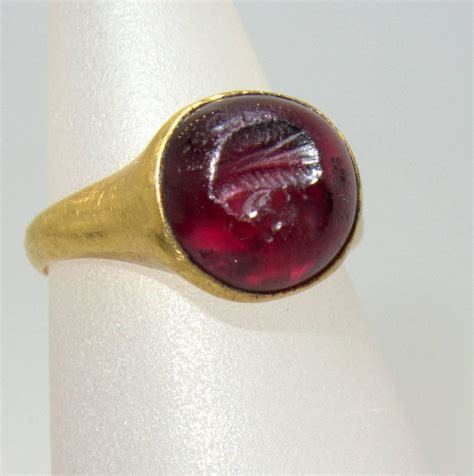
#superstition#folklore#ruby#birthstone#july#history#gemstone#jewelry#good luck#lucky#romance#crown jewels#united kingdom#black prince#edward black prince
13 notes
·
View notes